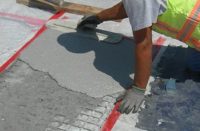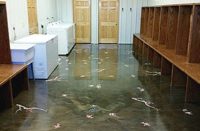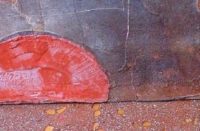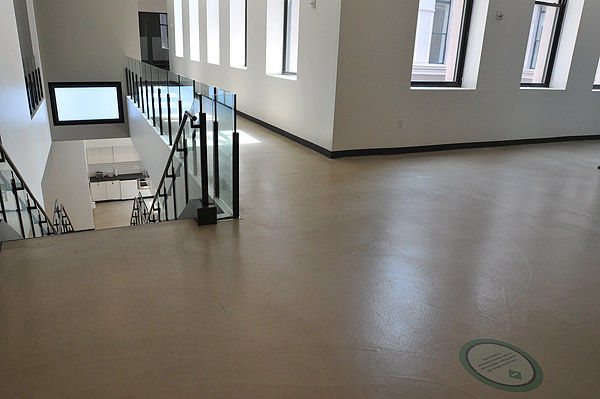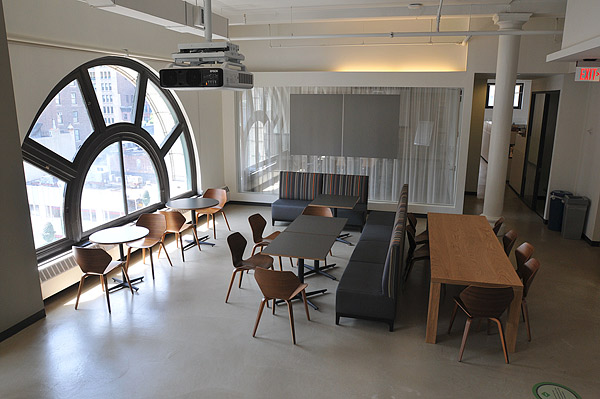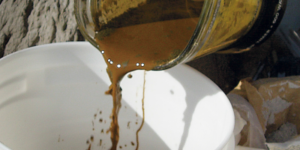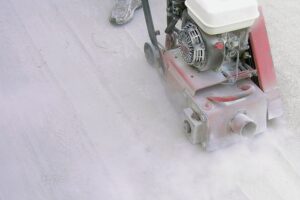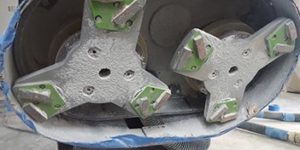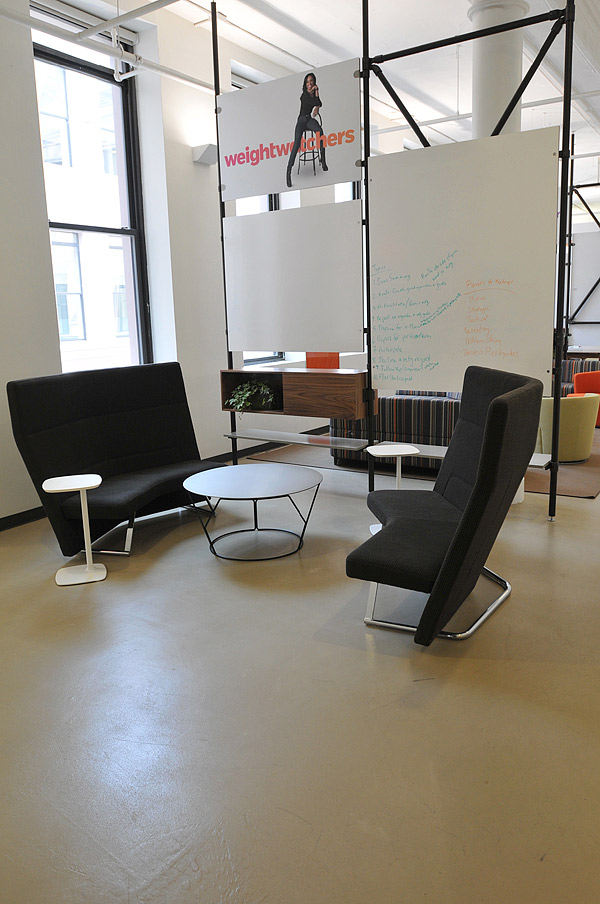
Concrete Concepts of NJ Inc. collectively burned some major calories when installing new flooring at the Weight Watchers International corporate offices in New York City.
The company’s crew flat-out hustled, and then some, to get the job done on time.
“We were three weeks late starting out,” says Concrete Concepts owner Amedeo Cilli. That’s because the company had taken over for a nonunion contractor that initially contracted to do the job.
Another two weeks elapsed before Concrete Concepts started work, as the company negotiated a contract for the project.
“By the time we hit the job, it was six weeks behind, and they had to open in three weeks. We’re talking 20,000 square feet. I thought, ‘This is a joke,’” Cilli says.
“We began working the most insane hours we have ever worked,” he says. “Most of the guys were doing 16-hour double shifts. The biggest pour was on Easter Sunday, to try to meet the deadline.” The move-in date for the owner was ironclad, with no wiggle room.
The job called for installation of cementitious overlays on three floors of the building — the fourth, fifth and sixth floors of a building at 675 Avenue of the Americas in Manhattan. The structure, considered postmodern in architectural style, dates to 1901.
“It’s a very old building with wood floors, and they wanted concrete,” Cilli says. “There were maybe 10 layers of other tenants’ stuff on (the floors)” — adhesive and VCT tile, primarily. Underneath was a plywood floor, over the top of the original wood plank flooring.
To remove the tile and other remnants of previous floor coverings, Concrete Concepts used hand-scraping tools and a Prep/Master STI-3030 grinding machine from Substrate Technology Inc. with a carbide bit, an effective approach for softer materials such as vinyl tile, Cilli says. Hand-grinding tools were used around edges.
The crews also had to wade through dirt and debris left by other trades, such as drywall installers, at work on the renovation of the office space. Here, Concrete Concepts put to use a recently purchased HTC 80 iD vacuum system, equipped with a high-performance, integrated “preseparator” that is reported to remove up to 95 percent of dust and debris, increasing filter life.
The scenario differed on the sixth floor, where the crew found that the subfloor was covered with an existing gypsum-based material. Here, it was decided that the best approach was to leave the “gypcrete” in place and use a high-performance primer to install the new cement-based flooring system.
Installation of the flooring system began with attachment of wire lath to the plywood flooring.
The flooring was put down in common areas of the three floors — lobbies, food courts and hallways.
Getting things rolling
Following extensive masking of adjacent walls, Concrete Concepts got things rolling with application of a primer coating — Duraamen Engineered Products Inc.’s Param Premium Primer, a styrene-acrylic formula specifically designed for use on self-leveling concrete flooring. After adequate dry, diamond metal mesh was installed. Here, Cilli says the size of the job necessitated the purchase of pneumatic nail guns, as it was immediately evident that nailing by hand wouldn’t cut it with the project’s aggressive timetable.
Another coat of the same primer was spray-applied after lath installation. Then came 3/8 inch of Duraamen’s Param 5500 self-leveling concrete, a CSA-based material that can be applied at thicknesses of 1/4 to 1 1/2 inch.
The following day, a 120-grit sanding screen was employed, using a floor-buffing machine, to address residual surface byproducts of the cement hydration process. Duraamen general manager Victor Pachade says this step is standard practice with installation of the self-leveling concrete.
Two coats of another primer product — Duraamen’s CP1000 premium-grade acrylic copolymer — were then applied to the self-leveling concrete. The high-solids, crosslinking acrylic emulsion offers a high degree of adhesion to various substrates, and it is also used as an additive in the company’s microtoppings.
The multistep installation process then moved to the microtopping phase, with three coats of Duraamen’s cement-based Skraffino, using a custom color blend, a type of beige. The microtopping colors are produced on the job site by mixing the microtopping cement and color pigments.
Cilli says the microtoppings varied in composition, with larger-grit sand in the first layer, a medium grit in the second and the “superfine” grade for the top layer. Cilli says the superfine grade of the microtopping is the only material of its type he knows of that can be applied using a spray gun. Application in this way produces the glass-smooth surface specified for the flooring — zero trowel marks.
For the color, Concrete Concepts’ objective was a match of the color chosen by the design team and the original flooring contractor on the job. The contractor had provided a sample of the color, which Cilli referred to as “Cork.” But the exact formula was not available. Experimenting with different blends, Cilli says the crew needed five tries to get it right. “We hit it dead on, eventually.”
Also added to the microtopping formula was the Cp1000 acrylic copolymer. The additive is reported to function as an accelerator in this type of use, boosting cement hydration and bonding to the substrate, says Duraamen’s Pachade.
The flooring system was completed with spray application of a sealer — Duraamen’s Perdure A03 clear acrylic — followed by roller application of the company’s Perdure E32 water-based epoxy primer/sealer, and finally with a spray application of Duraamen’s Perdure U45 water-based aliphatic polyurethane topcoat in a matte finish.
The system used on the sixth floor varied from the approach used on the fourth and fifth floors, as Concrete Concepts applied a different primer on the existing gypcrete surface. Here, the primer used was Ardex Feather Finish, a cement-based underlayment described as a blend of portland cement and other hydraulic cements.
Cilli says the relatively soft gypsum-based surface presents a difficult substrate for adhesion of cementitious flooring materials. Seeking the optimal solution, Concrete Concepts ran a series of tests on a section of the floor, using six different combinations of primers and microtopping. The Ardex product was found to offer the strongest bond, he says. “It sticks to everything, and everything sticks to it.”
From that starting point, the system components were identical to the approach used on the lower floors.
Logistical high-wire act
For Concrete Concepts, the job started out on days, but shifted to nights and weekends as flooring installation was wedged in around other aspects of the renovation.
“All the other trades were taking the space, and we saw it was going to be impossible to get them off the floor again, although the GC (general contractor) was trying,” Cilli says.
In working to coordinate the flooring installation with other contractors, Concrete Concepts and the GC came up with a plan to pour the self-leveling cement one floor at a time, make way for the other trades, then return some time later to finish with the microtopping layers. The project team decided that the most viable approach would be to set aside three separate weekends to finish the flooring installation — one weekend for each floor.
By the time Concrete Concepts crew returned to the scene, the cement surface installed earlier had been subjected to traffic from the other trades, and the first order of business was extensive cleanup.
“We would start with one crew on Friday night at 6 p.m. It would take two to three hours to clean the floor, to get back to where you were when we poured it,” Cilli says. Then, a new primer coat was applied using the Duraamen Cp1000, followed by a first microtopping early the next morning. With several hours of dry time between coats, the microtoppings were completed by Saturday night.
The first two microtopping layers were poured and troweled, while the third layer was sprayed out of a paint gun. “This is done when the customer wants a look that is not troweled,” Cilli says.
By Sunday, the flooring was in place, and the crew applied the topcoats and sealers over a period of several hours.
Concrete Concepts pulled out all the stops to get the job done, Cilli says, as his crews worked nearly nonstop over the three weekends to meet the timetable, with each crew of about five working 12-hour shifts or more.
But pace was only part of the story, as Concrete Concepts had also devised and executed a complex, multiphase flooring installation program to essentially create a shimmering, decorate-concrete floor on a base of plywood and gypsum substrates.
“It was out of the ordinary in that we were trying to turn a plywood floor into a concrete floor,” Cilli says. He contrasted this multicomponent job with another recent project, a decorative microtopping on a newly placed concrete floor in the Empire State Building. “We only used one coat of the superfine (microtopping), because there was a perfect new concrete floor in place,” he says.
“The first challenge was, we were starting behind the eight ball,” he says of the Avenue of the Americas project’s accelerated timetable. Then there was the matter of creating the decorative concrete floor on plywood, “one of the hardest of jobs to do,” he says. But the ultimate challenge, he says, was the logistical gymnastics required to make it all work.
Project at a Glance
Client: Weight Watchers International Inc.
Decorative concrete contractor: Concrete Concepts of NJ Inc., Amedeo Cilli, president | www.concreteconcepts.com
General contractor: Tri-Star Construction Corp., New York City
Architect: HLW International LLC, New York City | www.hlw.com
Scope of project Installation of cementitious flooring and microtoppings on three floors of a century-old office building in Manhattan’s Flatiron District
Most challenging aspects: Accelerated timetable for completion of installation of complex cementitious flooring system, installation of flooring system on existing plywood base, logistical complications due to presence of other construction trades during project
Duraamen products used: Param Super styrene-acrylic concrete primer, Param 5500 premium grade self-leveling concrete topping, Skraffino microtopping, Perdure A03 clear acrylic sealer, Perdure E32 water-based epoxy primer/sealer, Perdure U45 water-based aliphatic polyurethane topcoat, Cp1000 acrylic copolymer/primer
Other materials used: Ardex Feather Finish
Equipment used: Prep/Master STI-3030 grinding machine from Substrate Technology Inc., HTC 80 iD vacuum system
Shop Duraamen Products
Offered by Concrete Decor Store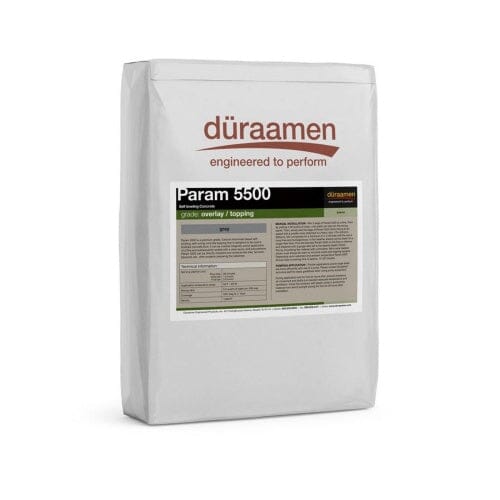 Param 5500- Self-leveling Concrete Overlay
Param 5500- Self-leveling Concrete Overlay
by Duraamen Engineered Products Inc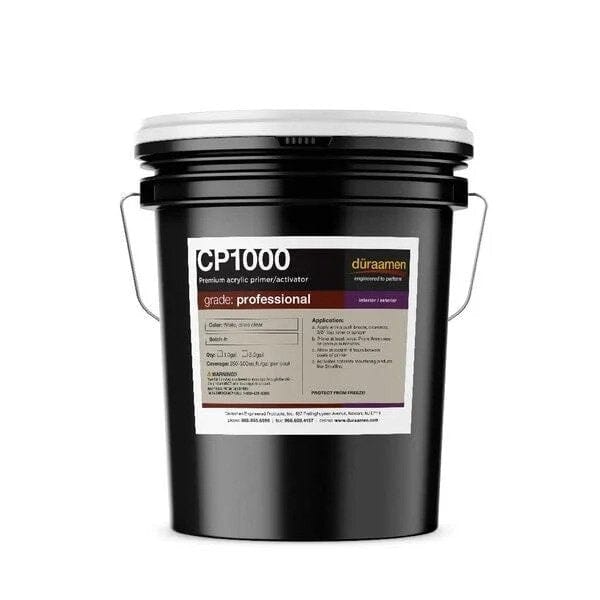 CP1000 - Premium Grade Acrylic Copolymer Primer
CP1000 - Premium Grade Acrylic Copolymer Primer
by Duraamen Engineered Products Inc Perdure A03 - UV Protective Clear Acrylic Sealer
Perdure A03 - UV Protective Clear Acrylic Sealer
by Duraamen Engineered Products Inc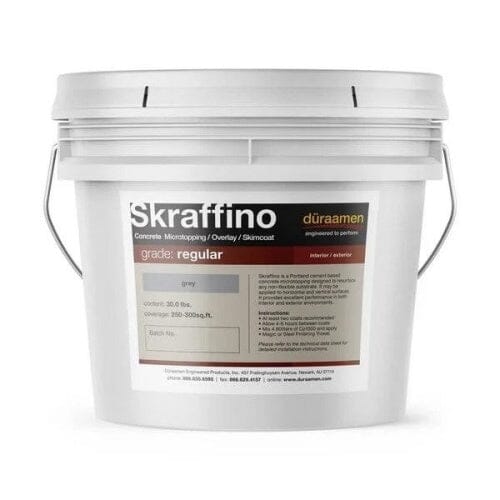 Skraffino - Concrete Microtopping
Skraffino - Concrete Microtopping
by Duraamen Engineered Products Inc
